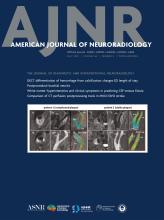Research ArticleNeurointervention
The Cortical Vein Opacification Score (COVES) Is Independently Associated with DSA ASITN Collateral Score
Dhairya A. Lakhani, Aneri B. Balar, Subtain Ali, Musharaf Khan, Hamza Salim, Manisha Koneru, Sijin Wen, Richard Wang, Janet Mei, Argye E. Hillis, Jeremy J. Heit, Greg W. Albers, Adam A. Dmytriw, Tobias D. Faizy, Max Wintermark, Kambiz Nael, Ansaar T. Rai and Vivek S. Yedavalli
American Journal of Neuroradiology May 2025, 46 (5) 921-928; DOI: https://doi.org/10.3174/ajnr.A8601
Dhairya A. Lakhani
aFrom the Department of Radiology and Radiological Sciences (D.A.L., A.B.B., H.S., R.W., J.M., V.S.Y.), Johns Hopkins University, Baltimore, Maryland
bDepartment of Neuroradiology (D.A.L., S.A., M. Khan, A.T.R.), West Virginia University, Morgantown, West Virginia
Aneri B. Balar
aFrom the Department of Radiology and Radiological Sciences (D.A.L., A.B.B., H.S., R.W., J.M., V.S.Y.), Johns Hopkins University, Baltimore, Maryland
Subtain Ali
bDepartment of Neuroradiology (D.A.L., S.A., M. Khan, A.T.R.), West Virginia University, Morgantown, West Virginia
Musharaf Khan
bDepartment of Neuroradiology (D.A.L., S.A., M. Khan, A.T.R.), West Virginia University, Morgantown, West Virginia
Hamza Salim
aFrom the Department of Radiology and Radiological Sciences (D.A.L., A.B.B., H.S., R.W., J.M., V.S.Y.), Johns Hopkins University, Baltimore, Maryland
Manisha Koneru
cCooper Medical School of Rowan University (M. Koneru), Camden, New Jersey
Sijin Wen
dDepartment of Biostatistics (S.W.), West Virginia University, Morgantown, West Virginia
Richard Wang
aFrom the Department of Radiology and Radiological Sciences (D.A.L., A.B.B., H.S., R.W., J.M., V.S.Y.), Johns Hopkins University, Baltimore, Maryland
Janet Mei
aFrom the Department of Radiology and Radiological Sciences (D.A.L., A.B.B., H.S., R.W., J.M., V.S.Y.), Johns Hopkins University, Baltimore, Maryland
Argye E. Hillis
eDepartment of Neurology (A.E.H.), Johns Hopkins University, Baltimore, Maryland
Jeremy J. Heit
fDepartment of Neurology (J.J.H., G.W.A.), Stanford University, Stanford, California
Greg W. Albers
fDepartment of Neurology (J.J.H., G.W.A.), Stanford University, Stanford, California
Adam A. Dmytriw
gDepartment of Radiology (A.A.D.), Harvard Medical School, Boston, Massachusetts
Tobias D. Faizy
hDepartment of Radiology (T.D.F.), Neuroendovascular Division, University Medical Center Münster, Münster, Germany
Max Wintermark
iDepartment of Neuroradiology (M.W.), MD Anderson Medical Center, Houston, Texas
Kambiz Nael
jDivision of Neuroradiology (K.N.), Department of Radiology, University of California San Francisco, San Francisco, California
Ansaar T. Rai
bDepartment of Neuroradiology (D.A.L., S.A., M. Khan, A.T.R.), West Virginia University, Morgantown, West Virginia
Vivek S. Yedavalli
aFrom the Department of Radiology and Radiological Sciences (D.A.L., A.B.B., H.S., R.W., J.M., V.S.Y.), Johns Hopkins University, Baltimore, Maryland

References
- 1.↵
- Berkhemer OA,
- Jansen IG,
- Beumer D
- 2.↵
- Liebeskind DS,
- Tomsick TA,
- Foster LD
- 3.↵
- Lima FO,
- Furie KL,
- Silva GS, et al
- 4.↵
- Nambiar V,
- Sohn SI,
- Almekhlafi MA, et al
- 5.↵
- Bang OY,
- Saver JL,
- Kim SJ, et al
- 6.↵
- Maas MB,
- Lev MH,
- Ay H, et al
- 7.↵
- 8.↵
- Higashida RT,
- Furlan AJ,
- Roberts H
- 9.↵
- 10.↵
- 11.↵
- 12.↵
- 13.↵
- 14.↵
- 15.↵
- 16.↵
- 17.↵
- 18.↵
- Faizy TD,
- Mlynash M,
- Kabiri R, et al
- 19.↵
- 20.↵
- 21.↵
- 22.↵
- Faizy TD,
- Mlynash M,
- Kabiri R, et al
- 23.↵
- 24.↵
- Faizy TD,
- Winkelmeier L,
- Mlynash M, et al
- 25.↵
- 26.↵
- Simera I,
- Moher D,
- Hoey J, et al
- 27.↵
- 28.↵
- Adams HP,
- Bendixen BH,
- Kappelle LJ, et al
- 29.↵
- Larrue V,
- von Kummer RR,
- Müller A, et al
- 30.↵
- Yedavalli V,
- Adel Salim H,
- Lakhani DA, et al
- 31.↵
- 32.↵
- Tan JC,
- Dillon WP,
- Liu S, et al
- 33.↵
- Dundamadappa S,
- Iyer K,
- Agrawal A, et al
- 34.↵
- Committee of the ASITN
- 35.↵
- 36.↵
- 37.↵
- 38.↵
- 39.↵
- 40.↵
- 41.↵
- Olivot JM,
- Mlynash M,
- Inoue M
- 42.↵
- 43.↵
- 44.↵
- 45.↵
- Xia H,
- Sun H,
- He S, et al
- 46.↵
- 47.↵
- Ben Hassen W,
- Malley C,
- Boulouis G, et al
In this issue
American Journal of Neuroradiology
Vol. 46, Issue 5
1 May 2025
Advertisement
Dhairya A. Lakhani, Aneri B. Balar, Subtain Ali, Musharaf Khan, Hamza Salim, Manisha Koneru, Sijin Wen, Richard Wang, Janet Mei, Argye E. Hillis, Jeremy J. Heit, Greg W. Albers, Adam A. Dmytriw, Tobias D. Faizy, Max Wintermark, Kambiz Nael, Ansaar T. Rai, Vivek S. Yedavalli
The Cortical Vein Opacification Score (COVES) Is Independently Associated with DSA ASITN Collateral Score
American Journal of Neuroradiology May 2025, 46 (5) 921-928; DOI: 10.3174/ajnr.A8601
0 Responses
COVES is Linked to DSA ASITN Collateral Score
Dhairya A. Lakhani, Aneri B. Balar, Subtain Ali, Musharaf Khan, Hamza Salim, Manisha Koneru, Sijin Wen, Richard Wang, Janet Mei, Argye E. Hillis, Jeremy J. Heit, Greg W. Albers, Adam A. Dmytriw, Tobias D. Faizy, Max Wintermark, Kambiz Nael, Ansaar T. Rai, Vivek S. Yedavalli
American Journal of Neuroradiology May 2025, 46 (5) 921-928; DOI: 10.3174/ajnr.A8601
Jump to section
Related Articles
Cited By...
- No citing articles found.
This article has not yet been cited by articles in journals that are participating in Crossref Cited-by Linking.
More in this TOC Section
Similar Articles
Advertisement











